Natya Shastra, compiled by Bharat Muni, divides musical instruments into four main categories on the basis of how sound is produced.
- Tata Vadya / Chordophones- String instruments
- Sushira Vadya / Aerophones- Wind instruments
- Avanaddha Vadya / Membranophones- Percussion instruments
- Ghana Vadya / Idiophones- Solid instruments
(1) TATA VADYA – STRING MUSICAL INSTRUMENTS

- Sound is produced by the vibration of a string or chord.
- Vibrations are caused by plucking or by bowing on the string which has been pulled taut.
- Length of string/wire, degree to which it has been tightened, determines the pitch of the note and also to some extent the duration of the sound.
- Four Main Types:
- Harps – Large string instrument, placed on ground and played.
- Lyres – Similar to Harp but small in size and can be carried on hand.
- Zithers – Strings are mounted on Body. Size of Instrument is limited to Sound Base. Example Santoor
- Lutes – String Instruments with Neck. Example: Veena, Sitar, Sarod
 String Instruments can be differentiated based on other paramters:
String Instruments can be differentiated based on other paramters:
- Based on Number of Strings: Monochord (Sitar) or Polychords (Veena).
- Fretted (guitar) or Frettless
- Based on method of playing- Plucked & Bowed
- Oldest evidence – harps in the shape of the hunter’s bow.
Examples of String Instruments:
Veena
 It is a Polychord
It is a Polychord- Played by Plucking strings
- Has 7-Strings
- Lute type of String Instrument as it has long neck
- Veena is mentioned in Vedas.
- In Hindustani (Northern) Music there are two types of Veena – Rudra Veena & Vichitra Veena
- In Carnatic ((Southern) Music there are again two types of Veena – Saraswati Veena & Chitra Veena.
Sitar
 Sitar is Monochord which essentially means that just one string is sufficient for playing whole melody.
Sitar is Monochord which essentially means that just one string is sufficient for playing whole melody.- Has long neck and has to be plucked for playing.
- Mainly used in Hindustani music.
- Amir Khusrao is said to have invented Sitar in 13th century.
Sarod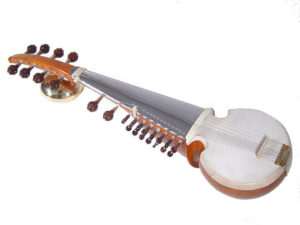
- Afghani Origin
- Sarod is short-necked, fretless string instrument.
- Used in Hindustani music
- Plucked with traingluar java.
Santoor
- Santoor is an example Zither type of String Instrument
- Smaller version of Santoor is called Swaramandal
- For melody Santoor is struck with thin bamboo sticks.
- Part of Kashmir tradition.
Sarangi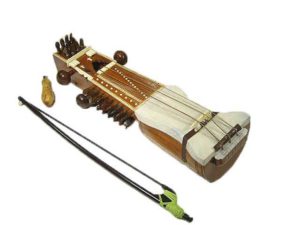
- Sarangi is Bowed instrument opposite to that of Violen which is bowed in inverted position.
- Example of Lute
- North India used.
(2) SUSHIRA VADYA- WIND MUSICAL INSTRUMENTS
- sound is produced by blowing air into an hollow column.
- pitch of the note is determined by controlling the air passage and the melody is played by using the fingers to open and close the in the instrument.
- The simplest of these instruments is the flute. Generally flutes are made of bamboo or wood and the Indian musician prefers these due to the tonal and musical attributes of these materials.
- Excavations of the Indus civilizations have shown bird whistles of clay, and seals which show wind and percussion instruments.
- There is reference in the Vedas to an instrument-the Venu which was used as an accompaniment to chanting and recitation. There is also mention of a kind of a flute called the Nadi.
Wind instruments are roughly divided into two categories on the basis of how sound is produced. They are:
Flutes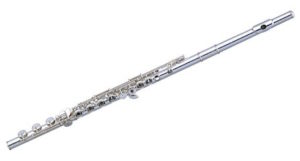
- Double flutes are mostly played by musicians of the tribal and rural areas
- They resemble beak flutes which have a narrow aperture at one end.
- One finds references to these types of instruments in the sculptures of the first century in the Sanchi Stupa which shows a musician playing on a double flute.
Reed instruments
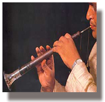 Reed instruments like the Shehnai, Nadaswaram, etc., have one or two reeds inserted in the hollow beak or tube of the instrument,
Reed instruments like the Shehnai, Nadaswaram, etc., have one or two reeds inserted in the hollow beak or tube of the instrument,- these vibrate when air is blown into them.
- reeds are bound together with a gap between them before inserting into the body of the instrument.
- The body of the tube is conical in shape narrow at the blowing end and opening out gradually with a metallic bell at the farther end to enhance the volume of the sound.
- A set of spare reeds, an ivory or silver needle for adjusting and cleaning the reeds are also hung from the mouth piece of the instrument.
(3) AVANADDHA VADYA – PERCUSSION MUSICAL INSTRUMENTS
- Sound is produced by striking the animal skin which has been stretched across an earthern or metal pot or a wooden barrel or frame.
- The earliest references to such instruments have been found in the Vedas where there is mention of Bhumi Dundhubhi; this was a hollow pit dug in the ground and covered with the hide of a buffalo or ox which was stretched across the pit.
- The tail of the animal was used for striking the animal hide and thus sound was produced.
The main categories are-Oordhwaka, Ankya, Alingya and the waisted or the Damaru family of drums.
Tabla
- Tabla pair is a set of two vertical Oordhwaka drums.

- right side is called the Tabla and the left, the Bayan or Dagga.
- Tabla has a wooden body with a covering of animal skin, this is held together with leather straps.
- Between the straps and the wooden body, oblong wooden blocks are placed for tuning the drums.
- syahi(ink) paste applied in the centre of the animal skin, the tabla can be tuned accurately by striking the rims with a hammer.
- body of the bayan is made of clay or metal and is covered with animal skin which also has syahi paste applied on it. Some musicians do not tune this drum to an accurate pitch.
- tabla pair is used as accompaniment to vocal and instrumental Hindustani music and with many dance forms of northern India.
- complicated talas of the Hindustani music are played with great virtuosity on the tabla.
- Prominent musicians playing the tabla today are-Ustad Alla Rakha Khan and his son Zakir Hussain, Shafat Ahmed and Samata Prasad.
Ankya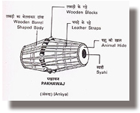
- Ankya drums are held horizontally before the musician and usually both sides are covered with animal hide.
- Sound is produced by striking both sides with sticks or fingers.
- Mridangam, Pakhawaj, Khol, etc. are prominent.
- musician may sit on the floor and play the instrument or hang it from the neck while dancing or standing.
- Seals which have been excavated of the Indus Civilization show figures of men playing the horizontal drums hung from the neck.
Oordhwaka
- Oordhwaka drums are placed vertically before the musician and sound is produced by striking them with sticks or the fingers.
- Prominent among these are the Tabla pair and Chenda.
Alingya
- drums have the animal hide fixed to a wooden round frame and are embraced or held close to the body with one hand while the other hand is used for playing on the instrument.
- Duff, Dufflies, etc. are very popular.
Damaru 
- Instruments in this category range from, the small Huddaka of Himachal Pradesh to the larger instrument known as Timila of the southern region.
- Huddaka is struck with the hands while Timila is hung from the shoulders and played with sticks and fingers.
- Also known as the hourglass variety of drums as their shape resembles an hourglass.
(4) GHANA VADYA – SOLID MUSCIAL INSTRUMENTS
- Earliest instruments invented by man are said to be the Ghana Vadya.
- Once constructed, this variety of instrument do not need special tuning prior to playing.
- principally rhythmic in function and are best suited as accompaniment to folk and tribal music and dance.
Jhanj Player, Konarak, Orissa
- In the Sun temple of Konarak, Orissa, we see this large sculpture of a lady playing the Jhanj.
Ghatam, Carnatic music of South India.
 Ghatam is an earthenware pot; the artist uses the fingers, thumbs, palms, and heels of the hands to strike its outer surface.
Ghatam is an earthenware pot; the artist uses the fingers, thumbs, palms, and heels of the hands to strike its outer surface.- An airy low-pitch bass sound, called gumki, is created by hitting the mouth of the pot with an open hand.
- artist sometimes presses the mouth of the pot against their bare belly, which deepens the tone of the bass stroke, and is another way to produce the gumki sound.
- Different tones can be produced by hitting different areas of the pot with different parts of the hands.
- The ghatam usually accompanies a mridangam.
Musical Instruments of India

